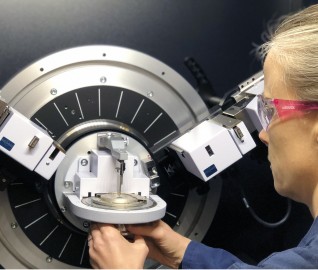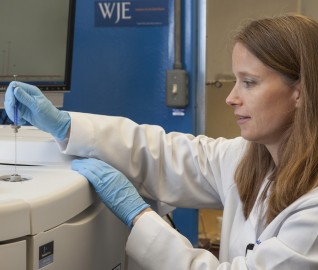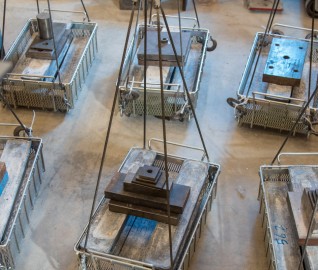Moisture in concrete floor slabs affects the performance of flooring systems such as resilient, wood, and textile floor coverings and coatings. Manufacturers of such systems generally require moisture testing be performed before installation of coverings on floor slabs and screeds. The measurement of sub-surface comparative moisture condition in the upper 1.0 in. (25.4 mm) stratum of a concrete slab with a non-destructive moisture meter is one such method. Excessive moisture in floor slabs after installation can cause floor covering system failures such as delamination, bonding failure, deterioration of finish flooring and coatings, and microbial growth.
WJE laboratories are accredited by ANAB (ISO/IEC 17025) to perform testing standard ASTM F2659 for Preliminary Evaluation of Comparative Moisture Condition of Concrete, Gypsum Cement and Other Floor Slabs and Screeds Using a Non-Destructive Electronic Moisture Meter.
Contact us to learn more.
Keywords
ASTM F2659 - Concrete Slabs - Dew Point - Gypsum - Measuring Instruments - Moisture Content - Non-Destructive Electronic Moisture Meters - Relative Humidity
ICS CODE
91.060.30 (Ceilings. Floors. Stairs.)
UNSPSC CODE
30111500 (Concrete and mortars); 30111601 (Cement)
CITATION FORMAT
ASTM F2659-10(2015), Standard Guide for Preliminary Evaluation of Comparative Moisture Condition of Concrete, Gypsum Cement and Other Floor Slabs and Screeds Using a Non-Destructive Electronic Moisture Meter, ASTM International, West Conshohocken, PA, 2015,
www.astm.org
 John E. Pearson, Principal and Laboratory ManagerWJE Northbrook MORE >People | John E. Pearson, Principal and Laboratory Manager
John E. Pearson, Principal and Laboratory ManagerWJE Northbrook MORE >People | John E. Pearson, Principal and Laboratory Manager WJE's Janney Technical Center (JTC) provides advanced testing and forensic capabilities to... MORE >Labs | Janney Technical Center
WJE's Janney Technical Center (JTC) provides advanced testing and forensic capabilities to... MORE >Labs | Janney Technical Center Our materials scientists provide comprehensive consulting services for the evaluation and... MORE >Services | Materials Evaluation and Testing
Our materials scientists provide comprehensive consulting services for the evaluation and... MORE >Services | Materials Evaluation and Testing WJE was founded on a spirit of innovation—that everything can be improved and that... MORE >Services | Product Development, Evaluation, and Testing
WJE was founded on a spirit of innovation—that everything can be improved and that... MORE >Services | Product Development, Evaluation, and Testing


































